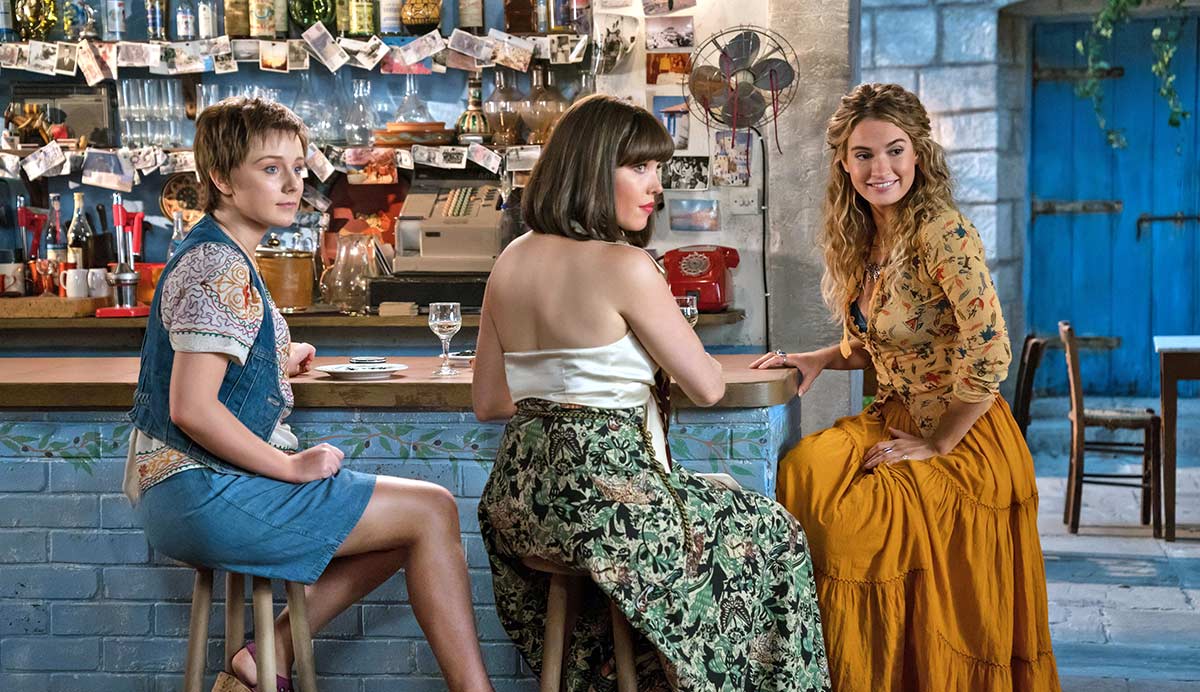The equivalent of a karaoke video made for tens of millions of dollars, “Mamma Mia! Here We Go Again” is silly, stupid and – Cher help me – so much fun. Your interest drops when you don’t know the ABBA song on screen (“When I Kissed the Teacher,” anyone?) in this jukebox musical sequel, but when you do, it’s impossible not to get swept up in the moment. This is not a good movie – but that doesn’t mean that it’s not a good time.
Jumping back and forth between 1979 and five years after the first film, this follow-up does as much as it can without Meryl Streep returning in the lead role as Donna. In its earlier storyline, it follows young Donna (Lily James) as she travels across Europe, meeting and falling for the 20-something versions of Harry (Hugh Skinner), Bill (Josh Dylan) and Sam (Jeremy Irvine) on the way to Greece. In the present(ish), Donna’s daughter, Sophie (Amanda Seyfried), is trying to launch the Hotel Bella Donna on that same Grecian island from the first film, despite the absence of her mother. She preps for the opening celebration with the help of the manager Señor Cienfuegos (Andy Garcia) and her mother’s beloved Sam (Pierce Brosnan), wishing that Bill (Stellan Skarsgård) and Harry (Colin Firth) could be there, too. The party –and the movie – really starts with the arrival of Donna’s best friends, Tanya (Christine Baranski) and Rosie (Julie Walters) in Greece for the hotel opening.
Writer-director Ol Parker rights one of the original 2008 movie’s biggest sins; though he casts relative unknowns as the younger versions of Sam, Bill, and Harry, all three actors can actually sing well, unlike their grown-up counterparts. One wonders what happened to each of them in the ensuing decades to cause the decline in their voices, but “Mamma Mia! Here We Go Again” isn’t big on verisimilitude. In present-day scenes, Brosnan, Skarsgård, and Firth sing less than they were tasked with in the original, and they still get to be their charming selves. And while Streep’s singing wasn’t the draw in the first film, James’ voice is lovely and she ably steps into the lead. She captures the wildness and abandon that Streep brought to Donna in “Mamma Mia!” but it doesn’t ever feel like she’s doing a Streep impression.
As great as James is in the lead, the movie really belongs to Baranski, as well as a small part from Cher. Baranski is doing everything we love about her, all arched eyebrows and arch humor. She’s having a blast, but she’s not having nearly as much fun as Cher does in just a few minutes of screen time late in the film. It’s a glorified cameo, but it brings such outsized joy to the audience that I can’t help but wish that they center a third film around her character (do not make me regret this desire, film gods). But the film’s real unsung hero might be Sofia (Maria Vacratsis), the Greek cafe owner who helps young Donna find her footing and steals every scene she’s in.
As someone whose primary knowledge of ABBA comes from one viewing of the first film, 57 viewings of “The Adventures of Priscilla, Queen of the Desert” and time spent in dentists’ offices, I wasn’t familiar with many of the songs featured here, and jukebox musicals like this really rely on the audience’s nostalgia for the original recordings. “Mamma Mia!” likely wasn’t intended to have a sequel, so the first film depleted many of ABBA’s top hits. This outing goes deeper into the catalog, but the theater and the film’s energy didn’t really pick up until a more recognizable single – “Waterloo” – makes its appearance. The film’s first act plods by, lacking the fun that marks its second half, with the blame falling both on less familiar songs and Parker’s script. Sophie’s plotline is marked by heartbreak, particularly in a fight with her husband, Sky (Dominic Cooper), and these scenes simultaneously lack the buoyancy and poignancy of later ones.
This often doesn’t look or sound like the sequel to a movie that made $610 million worldwide, particularly from a technical perspective. Backgrounds look fake, and some of the vocals have been clearly and not particularly skillfully improved. It’s also a level of cheese that we often don’t get on the big screen, resulting in eye rolls or giggles – or both simultaneously (try not to sprain anything). It’s often ridiculous, but it’s also frequently aware of just how silly it is. There’s no real plot, with individual scenes and whole arcs simply existing to give an intro to a largely forgotten ABBA song.
But despite all those flaws, “Mamma Mia! Here We Go Again” is full of delights. It’s a deep-fried slice of halloumi – gooey, fatty and free of nutrients – delivered to the audience on a platter with a flourish. They’ll struggle not to lick the plate when they’ve finished it. [C for the movie; B+ for the experience]





